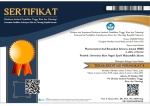Isolasi dan Karakterisasi Bakteri Endofit dari Daun Sirsak Annona Muricata L. dan Aktivitas Antibakterinya terhadap Beberapa Bakteri Patogen
Abstract
Soursop (Annona muricata L.) is a plant with many health benefits. Soursop leaves are widely used as traditional medicine by Indonesian citizen for wound infection healing. The antibacterial activity of soursop leaves cannot be separated from the presence of endophytic microbes that live inside. Endophytic bacteria live in plant tissues and have beneficial for their host plants. Endophytic microbes are able to produce same secondary metabolites as their host such as producing antibacterial compounds. Thirty one bacterial endophytes were isolated from soursop leaves that from 3 different regions: Garut, Cianjur, and Sukabumi. Morphologically, endophytic bacterial isolates from the three regions had different diversity. Bacterial isolates were tested for their activity against 4 test pathogenic bacteria, such as Pseudomonas aeroginosa, Escherichia coli, Staphylococcus mutans, and Streptococcus aureus. Antibacterial test using disc diffusion method with chloramphenicol 500 m/mL as positive control. Based on the antibacterial activity test, isolate G42 was able to inhibit all types of test bacteria. G42 isolates forms a zone of inhibition up to 17 mm in P. aeroginosa. Based on 16S rRNA, G42 isolates had similarity with Pantoea wallisii up to 93.24%. This study shows that endophytic bacteria isolated from soursop leaves have the potential to be developed into antibacterial agents.
Keywords
References
Adjie, S. (2011) Dahsyatnya Sirsak Tumpas Penyakit. Jakarta: Pustaka Bunda
Adri, D. dan Wikanastri, H. (2013) ‘Aktivitas antioksidan dan sifat organoleptik teh daun sirsak (Annona muricata Lin.) berdasarkan variasi lama pengeringan’, J Pangan Gizi.(7):12-17.
Afzal, I. et al. (2019) “Plant beneficial endophytic bacteria: Mechanisms, diversity, host range and genetic determinants’, Microbiological Research, 221:36-49.
Alyssa, M. et al. (2015) ‘Pantoea: insights into a highly versatile and diverse genus within the Enterobacteriaceae’, FEMS Microbiology Reviews, 27(39), pp. 968-984.
Desriani, et al. (2013) ‘Potential endophytic bacteria for increasing paddy var rojolele productivity’, Int. J. on Adv. Sci., Eng. and Information Tech, 3 (1) : 76-78.
Gajalakshmi, S. et al. (2012) ‘Phytochemical and pharmacological properties of Annona muricata: A Review’, Inter J. PPS, 4(2): 5.
Gavini, F. et al. (1989) ‘Transfer of Enterobacter agglomerans (Beijerinck 1888) Ewing and Fife 1972 to Pantoea gen-nov as Pantoea agglomerans comb nov and description of Pantoea dispersa sp-nov’, Int J of Syst Bacteriol, 39:337–345.
Ghadin, N. et al. (2008) ‘Isolation and characterization of a novel endophytic Streptomyces SUK06 with antimicrobial activity from Malaysian plant’, Asian J. Plant Sci, 7:2:189-194.
Lans, C.A. (2006) ‘Ethnomedicines used in Trinidad and Tobago for urinary problems and diabetes mellitus’, J. Ethnobiol Ethnomed, 2:45-55.
Latupeirisa, Y. (2014) Seleksi Dan Identifikasi Bakteri Bermanfaat Asal Tanaman Pisang Tongkat Langit (Musa troglodytarum L.) Untuk Mengendalikan Penyakit Darah Pisang, Bogor: Institut Pertanian Bogor.
Mano, H. dan Morisaki, H. (2008) ‘Minireview: Endophytic bacteria in the rice plant’, Microbes and Environments, 23:109-117.
Marchesi, J.R. et al. (1998) ‘Design and evaluation of useful bacterium specific PCR primer that amplify genes coding for bacterial 16SrRNA’, Appl Environ Microbiol, 64:795-799.
Nadarasah, G. dan Stavrinides, J. (2014) ‘Quantitative evaluation of the hostcolonizing capabilities of the enteric bacterium Pantoea using plant and insect hosts. Microbiology’, 160:602-615.
Nursulistyarini, F. (2014) ‘Isolasi dan Identifikasi Bakteri Endofit Penghasil Antibakteri dari Daun Tanaman Binahong (Anredera ccordifolia (Ten.) steenis)’, Yogyakarta: Universitas Negeri Sunan Kalijaga
Pileggi, M. et al. (2012) ‘Isolation of mesotrionedegrading bacteria from aquatic environments in Brazil’, Chemosphere, 86:1127–32.
Purwanto, U.M.S. (2014) ‘Isolasi Dan Identifikasi Senyawa Antibakteri dari Bakteri Endofit Tanaman Sirih Hijau (Piper betle L.)’, Bogor : Institut Pertanian Bogor.
Qiao, H. et al. (2006) ‘Endophytic bacteria isolated from wheat and their antifungal activities to soil-borne disease pathogens’, Ying Yong Sheng Tai Xue Bao, 17(4):690-694.
Rosidah, dan Afizia, W.M. (2012) ‘Potensi ekstrak daun jambu biji sebagai antibakterialuntuk menanggulangi serangan bakteri Aeromonas hydrophila pada ikan gurame (Osprhonemus gouramy lacepede)’, J Akuatika, 3(1): 19-27.
Roy, S. dan Banerjee, D. (2010) ‘ Isolation Of Antimicrobial Compound By Endophytic Bacteria From Vinca Rosea’, International Journal of Current Research, 5:47-51.
Simarmata, R. et al. (2007) ‘Isolasi mikroba endofitik dati tanaman obat sambung nyawa (Gymura procumbens) dan analisis potensinya sebagai antimikroba’, Berk Penel Hayati, 13: 85-90.
Smits, T.H.M. (2019) ‘Pantocin A, a peptide-derived antibiotic involved in biological control by plant-associated Pantoea species’, Archives of Microbiology’, 201: 713–722.
Tianxing, L. et al. (2013) ‘Potential of endophytic bacteria isolated from Sophora alopecuroides nodule in biological control against Verticillium wilt disease’, AJCS, 7(1):139-146.
Volksch, B. et al. (1993) ‘Occurrence of antimicrobial activities of bacteria from soybean leaf spots’, J Basic Microbiol, 33:349-355.
Walterson, A.M. et al. (2014) ‘Identification of a Pantoea biosynthetic cluster that directs the synthesis of an antimicrobial natural product’, PLoS One, 39: 968–984
Xiao, J.1. et al. (2014) ‘Secondary metabolites from the endophytic Botryosphaeria dothidea of Melia azedarach and their antifungal, antibacterial, antioxidant, and cytotoxic activities’, J Agric Food Chem, 62(16):3584-3590.
Zhang, S.M. et al. (2008) ‘Isolation and characterization of antifungal endophytic bacteria from soybean’, J Microbiol, 35(10):1593-1599.
Zheng, K. et al. (1995) PCR-based marker assisted selection in rice breeding. IRRI discussion paper series No. 12. International Rice Research Institute, P. O. Box 933, Manila, Philippines.
DOI: 10.15408/pbsj.v3i2.24321
Refbacks
- There are currently no refbacks.






